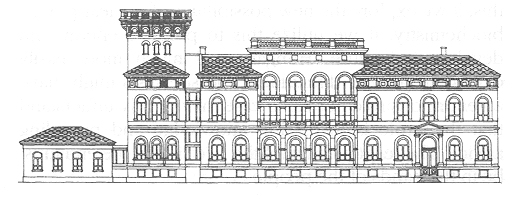
The old Physics Block of the Budapest University (1899-1999), designed by Prof. Roland Eötvös
Fizikai Szemle honlap |
Tartalomjegyzék |
Dénes Berényi, chairman
Committee for Hungarian Scientists Abroad
at the Hungarian Academy of Sciences
Universities
Scientific life in Hungary began at the universities. The first university was created by the king in Pécs in the 14th century, but it did not survive the storms of the history. The present University in Pécs proudly carries the name of the poeta doctus, Janus Pannonius, who was related to the Renaissance university.
An other university, created by the Hungarian king in the North-West in the late 15th century, moved to Buda(pest). Among others, Johannes Müller (alias Regiomontanus, 1436-1476) was invited by the king to Hungary; he as Astronomer Royal elaborated the Tabula Directorum, which was used also by Columbus while sailing westward. This university also disappeared during the two-century long fighting with the Ottoman Empire.
In these troubled centuries the Calvinist College emerged in Debrecen (16th century), which survived the storms of the history till today. Johannes Andreas Segner (inventor of the Segner Wheel) also worked in Debrecen. The College developed later to the University of Debrecen (East Hungary), and educated the most prominent experimentalists for this speculation addict nation.
As a counterbalance to the Reformation, cardinal Peter Pázmány created a Jesuite College in Western Hungary, which was more under Habsburg (Austrian, Roman Catholic) influence; this developed to the present Eötvös University in Budapest. (It was created in 1635, one year before Harvard, and moved to Buda(pest) after the expulsion of the Ottoman Army, in 1777.) One of its most influenceful scientists was the Benedictine monk, Ányos Jedlik (1800-1895), who brought optics and electricity to the traditionally mechanics-oriented country. (He fabricated optical grating, electromotor, even dynamo not for research or technology, but for impressive lecture demonstrations.) The most respected physics professor was Baron Roland Eötvös (1848-1919), who connected Hungarian physics to the scientific world. He served as rector, even as Minister of Education. Eötvös is considered to be the initiator of geophysics. The University of Budapest has taken the name Roland Eötvös University for his honor in 1950.
The old Physics Block of the Budapest University (1899-1999), designed by Prof. Roland Eötvös
Fourth on the list is the University of Szeged, from Transylvanian roots it was created in 1920. Its scientists excelled in bringing the air of modern physics (atomic physics, quantum mechanics), molecular biology and cybernetics to the country.
In the 20th century, the Technical Universities of Budapest, later on in Miskolc and Veszprém played a role in education, research and development, comparable to the Universities of Science.
The Hungarian Academy of Sciences
Western Hungary was a part of the Roman Empire. Since the Middle Age, Latin was the formal language of administration, culture, education and science. Later on, under the influence of the Habsburg emperor-kings, German became the formal language. The Hungarian language, however, is not an Indo-European language, therefore the alien Latin and German usage created a gap between culture and people. Thus 200 years ago a movement declared the goal, to develop the Hungarian language and literature to such a level, that it could replace the Latin and German languages also in education and science.
In 1825, Count István Széchenyi donated his whole yearly income for the creation of the Hungarian Academy of Sciences. The first goal of this Academy was to make the Hungarian to the language of culture and arts.
The first physicist member of the Academy was Ányos Jedlik. He proposed the election of revolutionary scientists like Faraday (1858), Claustus (1872), Boltzmann (1888) to honorary members of our Academy. No one can wish a more speedy recognition of scientific trends! Roland Eötvös (the creator of the Hungarian Physical Society in 1891) was the president of the Academy (1889-1905). On his side Kálmán Szily (the creator of the Hungarian Science Association for the popularization of science in 1869) was secretary general of the Academy (1889-1905). This was a brilliant period of increasing respect of science for the nation. (The best known Hungarian scientists were born in this period.) The membership of the Academy included poets and aristocrats as well, but e.g. Béla Bartók and Zoltán Kodály were also elected members, honoring their merits in the research of the Hungarian folksmusic.
After World War II, sensing the increasing importance of modern science in human culture and economy, Albert Szent-Györgyi (1893-1986, Nobel laureate for clarifying the structure and role of Vitamin C) shifted the center of weight from social sciences to natural sciences. In the 1950s the Academy created research institutes, in order to assist in the modernization of industry.
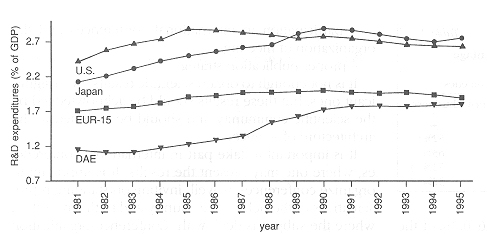
Fig. 1. R&D expenditures in the percentage of GDP between 1981 and 1995 in the U.S., Japan and in the countries of EU (EU-15), as well as at the "small tigers" (DAE)
At present, the Hungarian Academy of Sciences has 11 divisions, one for physics, one for mathematics, one for chemistry, one for technology etc. It has 200 elected members. (Those above the ege of 70 are not counted.) One of the main goals of our Academy is to keep the contact with the scientists with Hungarian roots alive worldwide. Thus Nándor Balázs, Gábor Domokos, Zoltán Gábos, George Grüner, Paul Halmos, John Harsanyi, Eva Klein, George Klein, Nicholas Kurti; Julius Kuti, János Ladik, Peter Lax, Andrew F. Nagy, George Olah, Huba Õry, Rudolf Pauncz, László Rybach, Gábor Somorjai, George Szekeres, Valentine Telegdi, Edward Teller, Laszlo Tisza, Tibor Toró, Eugene P. Wigner, among other prominences, were and are not only honorary members of our Academy, but took and teke active part in the scientific life of Hungary.
Research institutes
One of the roles of the Hungarian Academy of Sciences is to operate national research institutes in those sciences, which demand greater concentration of manpower and installation. The Astronomical Observatory has been created 100 years ago (Miklós Konkoly-Thege) and now it is run by the Academy.
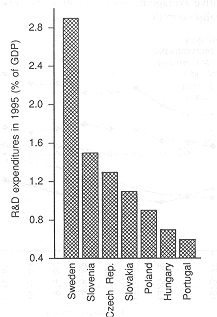
Fig. 2. R&D expenditures in the percentage of GDP in some European countries (1995)
Around 1950 or soon later larger research institutes were created for cosmic radiation and particle physics in Budapest (Lajos Jánossy), for nuclear physics in Debrecen (Sándor Szalay), for molecular biology in Szeged (Bruno F. Straub, disciple of Albert Szent-Györgyi, past president of UNESCO), for research reactor in Budapest (Lénárd Pál, past vice-president of the International Union for Pure and Applied Physics), for materials science in Budapest (József Gyulai, past vice-president of the International Union for Pure and Applied Physics), and for optics and solid state physics in Budapest (Norbert Kroó, past president of the European Physical Society). The fist is far from being complete. These institutes - as national laboratories - play nowadays decisive roles in research and development for the country.
Tendencies in the science of Europe and the world
Nowadays the states of the European Union are spending nearly 2% of their gross domestic product on the average to finance the research and development (R&D) sphere. This type of expenditures in Japan and the U.S. are well above this level while the "small tigers" are already approaching the European measures. The change and configuration of all these data from 1981 on are shown in Fig. 1. The same data for some European countries are given in Fig. 2.
The 5th Framework Programme of EU (for the period 1998-2002) emphasizes that if Europe wants to keep up with the U.S. and Japan, the average European research and development (R&D) expenditure should be raised from 1.9% to 2:5%.
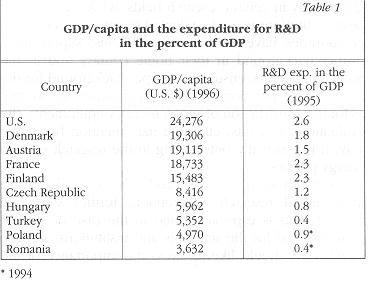
The value of the gross domestic product per person is generally used to determine the state of development of a country (this value alone, of course, is not satisfactory for this purpose). The position of Hungary, compared with some other countries from this point of view is shown on Table 1. In the last few years 0.6-0.7% of the gross domestic product was spent. for R&D sphera. The distribution of the financing expenditures between the governmental and non-governmental sphera is shown on Table 2.
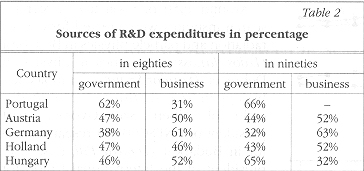
What can a small country like Hungary do in the world-wide scientific competition?
The question arises whether a small country has any chance to keep pace in the international research competition, considering that both research and development are very expensive nowadays. The possible breakthrough points can be summarized as follows:
In the last one or two decades the importance of international cooperation has become especially conspicuous. Not only the number of scientific results obtained with the common efforts of scientists of two or even more countries increased suddenly, but the number of joint European research institutions is about ten or more by now (e.g. CERN in Geneva for particle physics, ESO for astronomical research, or ESA, the European Space Agency). Even the larger, more developed European countries can achieve significant results with common efforts only in certain research fields, while in the European institutions even the talented scientists of the smaller countries have the same possibilities, supposing a proper background in their home country and in the home institutions, ensuring a proper background for the necessary preparations, preliminary experiments, as well as for the construction of supplementary equipments, the evaluation of results, etc. One may mention here Norway, it is especially outstanding in the research of high energy physics.
To play a significant role and achieve results in the international research competition, further steps are needed. This is especially valid in the case of smaller countries and for the scientists and institutions of these countries. I should like to stress the importance of the following issues:
It is not enough to obtain scientific results, even significant ones, but these results should be acknowledged by the scientific community and should be included in the architecture of science.
It is important to take part in international conferences, where one may present the results. It is important to organize conferences as well, inviting outstanding representatives of the field to the country and to the institution where the subject is dealt with. Conference-organization is time- and energy-consuming, but on a large scale it brings results.
Another important issue is the publication strategy. To publish scientific papers in a periodical which has no proper publicity is nearly the same, as if no results have been achieved at all.
The results of science in Hungary
The first part of the century, though the only Nobel prize-winner who got the prize for his results while living in Hungary, and for his research work carried out here is Albert Szent-Györgyi, but it is also known that there are about ten Nobel prize winners of Hungarian roots, who all began and carried out their studies in Hungary, even some of them began their scientific career in Hungary. For physicists Georg von Békésy, Eugene P. Wigner, Dennis Gabor, George de Hevesy may be mentioned. Apart from Nobel prize winner scientists there is a great number of internationally outstanding Hungarian scientists who can be similarly characterized, beside Edward Teller, Leo Szilard, Theodore von Kármán, John von Neumann, one may recall Zoltan Bay, Paul Erdõs, Nicholas Kurti, Valentine Telegdi, among others.
Fig. 3. The relative average number of citations per research paper in the former socialist countries
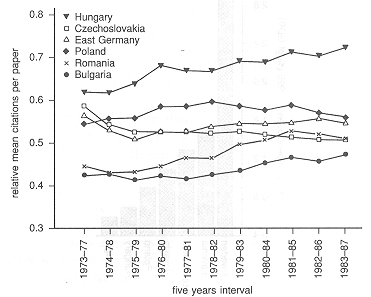
The eighties. Though the former political system brought along certain restrictions not only in the social sciences but also in the natural sciences, there is no doubt that at that time science in Hungary had considerable support, though as time was passing, in a decreasing degree. Fig. 3 shows a very important parameter (though we know that certain scientometrical parameters cannot be interpreted by themselves), the number of citation per publication in the 70s and 80s in Hungary and also in other socialist countries. It is striking that the position of Hungary is outstanding from this point of view, surely that was the result of the relative openness of our country for foreign cooperations. While our position in the world was the 53th from the point of view of GDP in the eighties, at the same time if we consider the number of publication, we are at the 26th (in physics the 27th) place, and taking the number of citations per publication, we are ranked at the 21st (in physics the 32nd) place. One may say that Hungary has all the better position the more rigorous parameters are taken into consideration. An evaluation for 13 European countries concerning physical researches has been elaborated - all the 13 countries included belong to the EU except Hungary. Here Hungary has the 10th position considering the number of publications and the 8th position taking the parameter of the number of citations per publication. The Table 3 shows how much money is spent in U.S. dollars on one publication, one citation and one patent license respectively.
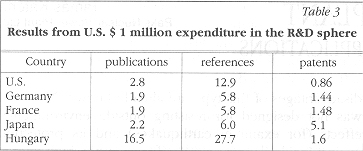
The ninties. In this period several new opportunities have arised and their number is still increasing. Table 4 shows the relative number of scientific papers in some countries published on research work in international cooperation.
Nowadays, more than 20 intergovernmental agreements and about 60 agreements of the Hungarian Academy of Sciences give the frame of cooperation in R&D efforts. We take part in R&D works under the programs EUREKA, COST, CERN, and those of NATO. Our country is a member in the EU R&D sphere. In 1995-96 we were taking part in the Copernicus program with 147 projects, and this number was the greatest among the former socialist countries.
It is worth mentioning how the Europhysics News or the Nature, one of the most respectful scientific papers in the world, wrote about Hungarian science in the lest few years. "The Committee of the European Community has recently proposed to Council that scientific cooperation with these countries should take place in fields in which the EC will gain advantages (e.g. Hungary is strong in statistics)" (Europhysics News).
"...Hungary is probably the state in Central Europe with the greatest scientific potential" (Nature). This issue of the Nature mentioned above was published with the Margaret-Bridge of Budapest on the front page, the Physics World had the Hungarian Parliament and the Hungarian national flag on its front page. This very issue was devoted to Hungarian science.
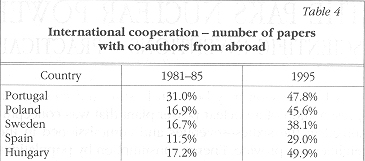
Perhaps the most remarkable statement is the one in a publication of EC in 1994 ("The European Report on Science and Technology Indicator - 1994") writing on science in Hungary: "Despite the severe fall in R&D and STS activities over the past ten years, Hungary remains relatively a good performer among the EIT countries, whether measured by input or output indicators::. Hungary is the only one of the EIT countries to appear in the top 20 countries in terms of citations per research paper and although patents taken out in Europe and in the United States have fallen, patents originating in Hungary in 1992 and 1993 were much greater than for any other EIT country, except the former Soviet Union ".
Today there is no lack in young Hungarian talents, though many scientists left Hungary and others left their speciality. It should be feared now that the most talented young people will choose other profession due to financial reasons. On the other hand, the possibility of foreign and international cooperation is available for Hungarian scientists. Actually, the financial support of science should be increased. We mean here not only the financial support by the government, which is absolute indispensable, but also by the nongovernmental sphere. While privatization was carried out in Hungary, several state institutes for industrial research and development have been closed down, and we may say that the research activity of the industry moved to abroad, to the centers of multinational companies. To call it back to Hungary would be important, it means a great problem similar to the one getting more Financial support.
Finally, we should consider what the Journal European Dialogue wrote in its 1998 September issue. The technological gap outlined by the Committee is similar to the economic gap, that can be observed between the member-countries of the European Union and the to-be members of EU. By technological gap we mean the difference in R and D activity of the EU countries and the countries waiting for admission. Actually, our position is determined by indicators showing how much money is spent on research, what results have been achieved, and how these results are introduced and realized in the national economy.